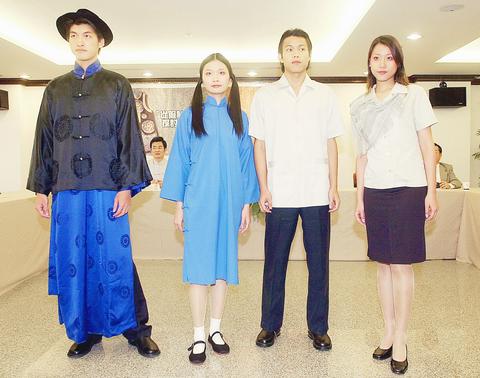As the government ponders whether to design a new national dress for Taiwan, scholars and fashion experts said yesterday that it is crucial that such an outfit be comfortable and modern -- and have a distinctly Taiwanese identity.
They made the remarks at a seminar hosted by the Ministry of the Interior yesterday for scholars, fashion experts and legislators to exchange opinions on whether there exists a need for designing a new national dress and what would be the appropriate style for such costume.

PHOTO: FANG PIN-CHIAO, TAIPEI TIMES
At the seminar hosted by Minister of the Interior Yu Cheng-hsien (余政憲), those in attendence also said that the Uniform and Dressing Regulation (服制條例), established 73 years ago, should be either amended or abolished, although no suggestions as to the content of an amended law were submitted.
The 1929 law states that government officials must wear national dress on formal occasions and when meeting foreign dignitaries, but this law has not been observed in decades.
In his opening speech to the seminar, Yu said that unlike many other countries such as Japan, Thailand and Korea, Taiwan does not have a national dress that reflects its image and spirit.
According to the Uniform and Dressing Regulation, Taiwan's national dress is the Manchurian-style long gown, and the civil servants' uniforms are "Chung-shan suits" (
"Since these old dress styles no longer suit modern society, the regulation must either be amended or abolished," Yu said.
"The ministry would like to gather expert opinions in the search for a beautiful form of dress for the Taiwanese people," said Yu.
According to the ministry, the new national dress should be formal wear designed for representing Taiwan on international occasions, similar to the kimono of Japan and the Indian sari.
Hu Tze-ming (胡澤民), a professor at Fujen Catholic University said that, although Western-style suits and ties are indispensable in modern society, it is crucial that Taiwan has a national dress that suits its subtropical climate and projects its distinctive image.
To win the acceptance of the general public, Hu suggested that strict rules should not govern the design of Taiwan's national dress but crucial elements that need to be included in the design should be clearly identified.
Lo Mai-ruei (羅麥瑞), another professor, said that since dress is a "power language" and is closely linked to a nation's history and culture, it is important for the Tai-wanese people to find out their cultural identity and blend it into the design of the national dress.
"The idea of multi-ethnic culture and the natural beauty of Formosa are all valuable sources in searching for the basic elements for the national dress," Lo said.
Huang Tsai-lang (黃才郎), director of Taipei Fine Art Museum, suggested that the creation of such a national dress should involve a gradual progress of accumulating thoughts and ideas from as many sources as possible in order to avoid controversy.
"However, the national dress should be comfortable, distinctive and elegant, and respect international social etiquette," said Huang.

Chinese Nationalist Party (KMT) Chairman Eric Chu (朱立倫), spokeswoman Yang Chih-yu (楊智伃) and Legislator Hsieh Lung-chieh (謝龍介) would be summoned by police for questioning for leading an illegal assembly on Thursday evening last week, Minister of the Interior Liu Shyh-fang (劉世芳) said today. The three KMT officials led an assembly outside the Taipei City Prosecutors’ Office, a restricted area where public assembly is not allowed, protesting the questioning of several KMT staff and searches of KMT headquarters and offices in a recall petition forgery case. Chu, Yang and Hsieh are all suspected of contravening the Assembly and Parade Act (集會遊行法) by holding

PRAISE: Japanese visitor Takashi Kubota said the Taiwanese temple architecture images showcased in the AI Art Gallery were the most impressive displays he saw Taiwan does not have an official pavilion at the World Expo in Osaka, Japan, because of its diplomatic predicament, but the government-backed Tech World pavilion is drawing interest with its unique recreations of works by Taiwanese artists. The pavilion features an artificial intelligence (AI)-based art gallery showcasing works of famous Taiwanese artists from the Japanese colonial period using innovative technologies. Among its main simulated displays are Eastern gouache paintings by Chen Chin (陳進), Lin Yu-shan (林玉山) and Kuo Hsueh-hu (郭雪湖), who were the three young Taiwanese painters selected for the East Asian Painting exhibition in 1927. Gouache is a water-based

Taiwan would welcome the return of Honduras as a diplomatic ally if its next president decides to make such a move, Minister of Foreign Affairs Lin Chia-lung (林佳龍) said yesterday. “Of course, we would welcome Honduras if they want to restore diplomatic ties with Taiwan after their elections,” Lin said at a meeting of the legislature’s Foreign Affairs and National Defense Committee, when asked to comment on statements made by two of the three Honduran presidential candidates during the presidential campaign in the Central American country. Taiwan is paying close attention to the region as a whole in the wake of a

OFF-TARGET: More than 30,000 participants were expected to take part in the Games next month, but only 6,550 foreign and 19,400 Taiwanese athletes have registered Taipei city councilors yesterday blasted the organizers of next month’s World Masters Games over sudden timetable and venue changes, which they said have caused thousands of participants to back out of the international sporting event, among other organizational issues. They also cited visa delays and political interference by China as reasons many foreign athletes are requesting refunds for the event, to be held from May 17 to 30. Jointly organized by the Taipei and New Taipei City governments, the games have been rocked by numerous controversies since preparations began in 2020. Taipei City Councilor Lin Yen-feng (林延鳳) said yesterday that new measures by